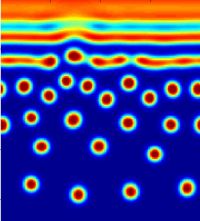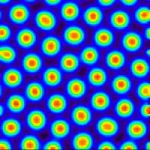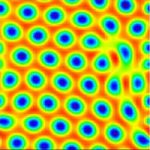
BioGeoChemistry of Tidal Flats
Pattern Formation in Sediments
Sediments are characterized by heterogeneous distributions of nutrients and microorganisms which emerge as a result of the interaction between chemical and biological processes with physical transport.
The reduced Sediment Model
In a simplified model we study the dynamics of a population of microorganisms and its nutrient. The fundamental processes, we consider in the system, are degradation of nutrient (organic material), affecting the growth of the bacteria's population, inflow and loss of bacteria, inflow of nutrient due to bioirrigation and -- as local transport process -- diffusion. As experimental studies show, we have to take into account that the considered bacteria possess an active as well as an inactive state, in which they do not contribute to degradation. Furthermore, the active bacteria can intensify the activation of dormant cells by the excretion of signal molecules. Consequently, in our approach we distinguish between an active part of microorganisms and an inactive one. The microbial activation can the be modelled as a function that is controlled by the population density of bacteria. Another special feature of our model is associated with bioirrigation, which acts as a non-local transport of nutrients. Thus our model is globally coupled.
|
Analysis The analysis of the model shows that Turing patterns can occur which yield heterogeneous spatial distributions of species. In particular this phenomenon of pattern formation presumes an autocatalytic growth of the bacteria population and a mobility of nutrients that exceeds that one of microorganisms. The first condition is a property following from the activation mechanism of bacteria, the second one is fulfilled due to the fact, that bacteria are bigger in size than the chemicals they feed on and that bacteria tend to stick on the sediment matrix. In computer simulations we performed on a twodimensional vertical domain, we analysed the effect of bioirrigation. We found that there are different types of patterns and that it depends on the strength of bioirrigation, what type is realized. In particular we found with increasing strength of the bioirrigation:
|
|

Result of a realistic simulation |
Realistic simulationTo model scenarios, that are more realistic, we have to model the bioirrigation as a depth dependent process. Additionally, we have to discard the assumption that the upper and lower boundary conditions are periodic. For a model that has been adjusted in such a way our results show that a special pattern can evolve, being characterized by a vertical sequence of all pattern types, we were able to identify by varying the bioirrigation parameter. |
Relevant publications
- M. Baurmann and U. Feudel; "Turing patterns in a simple model of a nutrient-microorganism system in the sediment". Ecological Complexity, 1(1):77-94,2004
- M. Baurmann, W. Ebenhöh and U.Feudel; "Turing instabilities and pattern formation in a benthic nutrient-microorganism system". Mathematical Biosciences and Engineering, 1(1):111-130,2004


